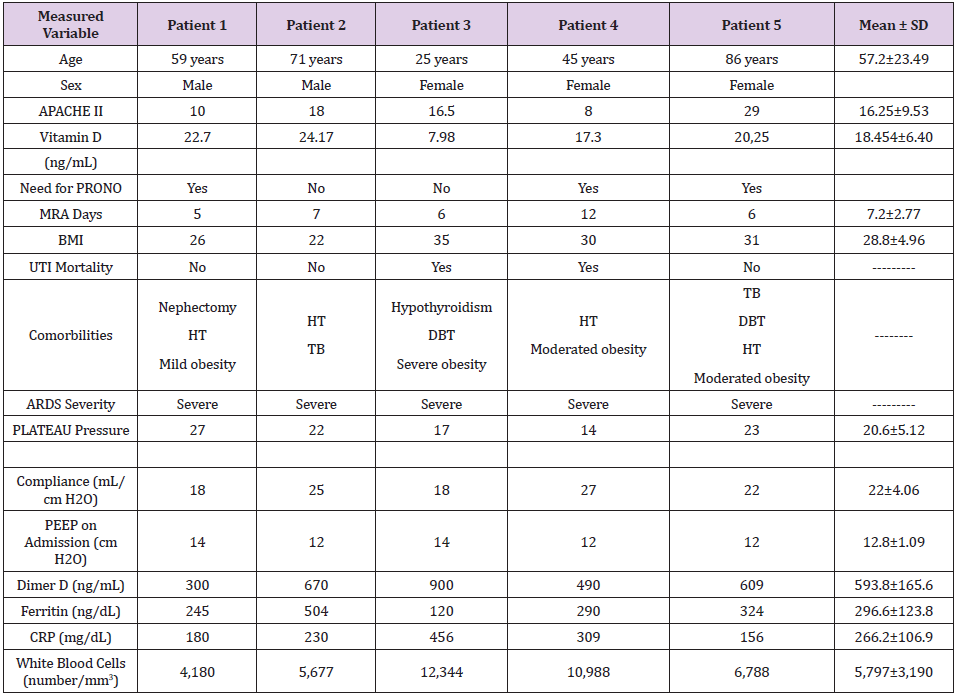Relationship Between Vitamin D Levels and Covid-19 Severity Due to Circulating SARS-COV-2 Variants in Argentina: A Presentation of Clinical Cases
Introduction
During the current pandemic of atypical pneumonia caused
by the SARS-CoV-2 coronavirus, it has been observed that vitamin
D (VD) deficiency would represent a significant risk factor in the
severity and prognosis of COVID-19 with a higher prevalence of
hypertension and cardiovascular diseases. As of August 2021,
Argentina was the second Latin American country with the highest
number of confirmed cases and the fifth with the highest number
of deaths from COVID-19, according to official statistics [1], despite
having been subjected to one of the longest quarantines of the
world, which justifies and strengthens the selection of this country
to carry out research works such as the one presented here.
Previous studies consider that the weighted average prevalence
of VD deficiency in the Argentine adult population is around
43.3% [2]. In this context, the present study aimed to investigate
the possible relationship between the evolution of the disease
concerning serum VD levels in a series of clinical cases of patients
with COVID-19. They were admitted to the critical care area of
Hospital Luis Carlos Lagomaggiore, Mendoza, Argentina.
Presentation of the Series of Clinical Cases
We present a series of 5 patients, 2 men and 3 women in an age range of 25 to 86 years, with a positive diagnosis by polymerase chain reaction (PCR) to detect SARS-CoV-2. They all required admission to the critical care unit due to acute respiratory failure and received the standard care recommended to manage this pathology (invasive hemodynamic monitoring, mechanical ventilation, and other procedures). Table 1 shows the clinical cases and the most outstanding variables analyzed. Biochemical/ inflammatory parameters were requested (vitamin D, D-Dimer, ferritin, ultrasensitive C-reactive protein, blood count, among others). Likewise, ventilatory mechanics measurements were performed at the time of linkage to mechanical ventilation (MRA). As observed in the series of cases presented, the serum VD levels in all the patients analyzed are below what is established as normal or sufficient levels of VD (> 30 ng/mL), reaching not only levels of insufficiency (<30 ng/mL), but even VD deficiency (<20 ng/mL). Regarding mortality, of the total sample (100%), 2 (40%) patients died. The deceased patients were identified as 3 and 4, and they also had the lowest values in the VD dosage (7.98 ng/mL and 17.3 ng/mL, respectively).
Table 1: Variables were analyzed in the 5 patients belonging to the series of clinical cases studied. Abbreviations: acute respiratory distress syndrome (ARDS), HT (hypertension), BMI (body mass index), TB (smoking), DBT (diabetes), ICU (intensive care unit), PEEP (end-expiratory pressure), MRA (mechanical ventilation), CRP (C-reactive protein), and Mean ± SD (mean ± standard deviation of the 5 patients) for the quantitative variables.
Discussion
The 5 patients studied showed a significant increase in
inflammatory parameters, accounting for the severity of the
COVID-19 developed, starring the characteristic cytokine storm.
Consistent with our results, some previous studies have suggested
the existence of an inverse relationship between serum VD levels
and the degree of severity due to COVID-19 [3-8]. However, none
of them has specifically evaluated this relationship in patients affected by the variants of SARS-CoV-2 Gamma (Manaus) and
Lambda (Andina), with a majority presence in Argentina at the
date of this study [9].Therefore, the importance of this research is
fundamentally in that its results would contribute significantly to
establish an inverse relationship between serum levels of VD and
severity of COVID-19 in patients infected by the variants mentioned
above, representing an essential contribution to the genomic
surveillance process [10], not only in Argentina, if not in all those
countries in the world that are mainly affected by the presence
of the Lambda and Gamma variants. This contribution would
significantly improve the prevention and treatment of COVID-19,
mainly when any of these variants develops the infection. Likewise,
additional studies should be performed in populations with another
viral circulation profile to evaluate this relationship (VD levels vs
COVID-19 severity) versus other SARS-CoV-2 variants.
For more Articles on : https://biomedres01.blogspot.com/



No comments:
Post a Comment
Note: Only a member of this blog may post a comment.